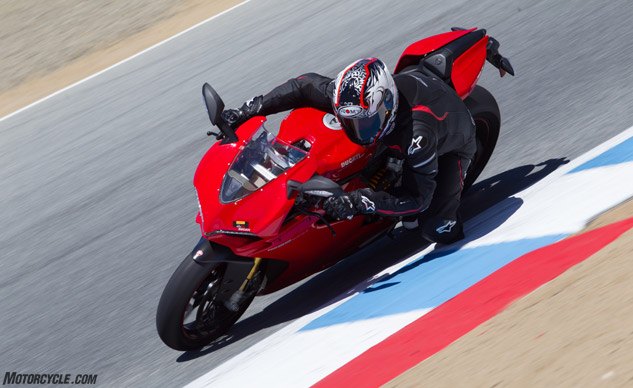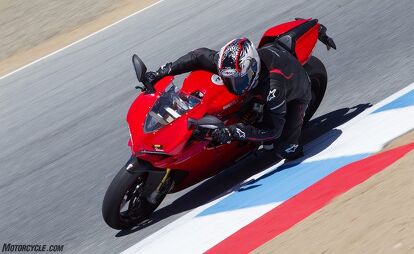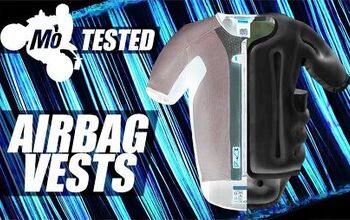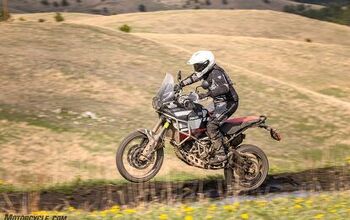How Far Off Is A Street Tire Versus A Track Tire, Really?

Comparing a sampling of Pirelli's street and track tires at Laguna Seca
Companies that go racing love to promote how the lessons learned at the racetrack trickle down to the products we use on the street. Besides being great marketing fodder, the idea behind racing is to develop products that will benefit the everyday consumer. We generally think of sportbikes (and liter-class sportbikes in particular) as being direct translations of racetrack development trickling down to production models, but we sometimes forget about the only part of the motorcycle in continuous contact with the road: its tires.
Thankfully, Pirelli hasn’t forgotten. In fact, Pirelli has been the sole tire supplier for the World Superbike Championship since 2004 and holds the same role for numerous domestic championships around the world (except in MotoAmerica, ironically). That experience has translated into an entire range of tires developed for everything from street riding to pro-level competition with direct feedback from racing.
That, then, begs the question: What’s the difference between a street tire and a track tire, anyway? To find an answer, Pirelli invited selected guests to try a sampling of tires on a variety of bikes at the iconic Mazda Raceway Laguna Seca. Those tires included the newest street tire in the Diablo line, the Diablo Rosso III, the Diablo Supercorsa SP, Diablo Supercorsa SC, and finally the Diablo Superbike slick.
Diablo Rosso III
The Diablo Rosso III was introduced late last year and is the successor to the popular Diablo Rosso II. Pirelli understands that as motorcycle genres are broadening in the sporting landscape, motorcycle tires need to adapt. The same holds true for the advancement in moto-technology – as it develops, so should the tire. The Diablo Rosso III is designed to be used on a wide range of motorcycles; from sportbikes to standards and sport-tourers, and everything in between.
Featuring a dual-compound rear for greater cornering grip and durable center section, the Rosso III is comprised of 100% silica for quick warm-up times and grip on wet roads. According to Piero Misani, Head of R&D at Pirelli, the racing influence comes in many forms. Firstly, the company has formulated new resins to help the tire maintain its grip and consistency over time. Second, the Rosso III shares more of its profile shape with the Diablo Supercorsa to provide slightly quicker steering feel compared to the Rosso II it replaces. The Rosso III’s tread design also borrows the lightning bolt pattern of the Supercorsa, but with more sipes for better water dispersion during wet riding.
Overall, the Rosso III is said to provide much better grip compared to the Rosso II, especially in the wet, maintain that performance for longer, and be suitable for a wide range of motorcycles.
I didn’t get to ride the Rosso III on the roads, but was able to spin laps at Laguna aboard both a Kawasaki ZX-6R and Z800. True to form, the IIIs warmed up quickly – I probably only needed half a lap – with stability under braking and turning characteristics similar to its more race-oriented siblings. The tire’s hard carcass is to credit for the braking stability, while the profile borrowed loosely from the Supercorsa gets credit for the latter.
The tire doesn’t inspire quite the confidence to drag an elbow on the ground, but does feel planted leaned over. I did notice a slightly greasy feeling as the laps piled up, causing me to trailbrake less and be more cautious with the throttle on exits, but that feeling eventually plateaued and remained consistent throughout the day and after several riders of varying skill levels rode the same bikes. It’s a solid choice for the occasional track rider, or those in the novice or intermediate groups, because of its quick warm-up times and durability.
Supercorsa SP and SC
As we’ve ridden on, and written about, the Supercorsa varieties before, I’ll spare the details of their makeup other than to differentiate between the two. The SP is the more street-oriented of the two Supercorsa varieties, with harder, more durable compounds that allow it to be better suited for the street. It comes as standard fitment on many of today’s high-end sportbikes. The SC, meanwhile, is the same tire used in World Supersport and Superstock competition. It comes in multiple compounds to suit different track conditions. Clearly, between the two, the SC is the one to have at Laguna.
Compared to the Rosso III, the SP provided more edge grip, allowing me to brake rather deep and lean pretty far on the Ducati 1299 Panigale S it was fitted to. Side grip was also impressive, as instead of spinning, calls for throttle were answered with the rear tire digging into the ground and launching the front wheel into the sky. It took me a full lap to get comfortable with the amount of heat/grip in the tire, but that may have been a conservative attempt at warming them considering the expensive machinery I was piloting.
The difference between the SP and SC (SC1 in this case, the softest front and middle-option rear, best suited for the widest range of conditions) is really best felt when riding the two back-to-back. This time aboard a Kawasaki ZX-10R, on which the SP provided good grip under braking and in corners, the SC gives off this aura of “Everything the SP can do, I can do better.” Sure enough, aggressive trailbraking into corners like Turn 2, which is approached at nearly 140 mph, doesn’t upset the tire at all – it tracks where you want with the side grip to tell you there’s still more left in reserve. On corner exits, the rear hooks up and drives you off, baiting the rider to twist the throttle earlier and earlier each time.
Diablo Superbike
The cream of the crop, the Diablo Superbike slick tire is a far better tire than I am a rider. If the Supercorsa SP whispers to you and the SC talks, the Slick screams. I tried the tire on both a Ducati 1299 Panigale S and Kawasaki ZX-10R and came away with similar impressions: I had difficulty approaching the tire’s limits.
I had taken over both bikes immediately after other riders had come in from their sessions, so I can’t comment on warm-up times, but what I can attest to is the sheer confidence the tire provides. Intentionally pushing my braking markers further caused me to trailbrake while carrying more speed, specifically into the fast entry for Turn 2. No matter; both the Ducati and Kawi fitted with the slick stayed true to course and composed on the binders.
Then, once on its side, line adjustments were a simple matter of looking where I wanted to go and having the bike follow. It felt as though my lean angle didn’t even matter – it would go where I pointed it, even while my elbow was on the ground! The entire time the tire’s profile felt very neutral – a trait shared across all of the tires I sampled on this day.
Rear grip is equally as impressive, especially exiting the fast Turn 4 where entry speeds are quick and exit speeds are even quicker because you’re on the gas as early as possible. The rear would squirm on acceleration and even cause the front to get light as the weight transfer moved rearward, but I never saw a TC light illuminate on either bike’s dash. The rear was simply flexing under acceleration, causing the wiggle, but putting down the power the entire time.
Racing Meets The Road
Pirelli’s Piero Misani explained to me that the reason Pirelli has remained in Superbike racing is because of the direct translation of Superbike technology to the street. After sampling this range of tires, the connection between the racetrack and the road makes perfect sense. The Diablo Rosso III may be for an entirely different customer than the Diablo Superbike slick, but the lineage between the two is unmistakable. The Diablo Supercorsa duo provide stepping stones (or even end points) as one’s riding skills – and budget – improve.
Even if you couldn’t care less about racing, the benefits learned from competition still apply no matter what kind of riding you do. The resources used in racing are also used to improve manufacturing and development for the entire Pirelli line – even tires for cruisers and customs. Ultimately, that means a safer, longer, more confidence-inspiring ride no matter what motorcycle you own.

Troy's been riding motorcycles and writing about them since 2006, getting his start at Rider Magazine. From there, he moved to Sport Rider Magazine before finally landing at Motorcycle.com in 2011. A lifelong gearhead who didn't fully immerse himself in motorcycles until his teenage years, Troy's interests have always been in technology, performance, and going fast. Naturally, racing was the perfect avenue to combine all three. Troy has been racing nearly as long as he's been riding and has competed at the AMA national level. He's also won multiple club races throughout the country, culminating in a Utah Sport Bike Association championship in 2011. He has been invited as a guest instructor for the Yamaha Champions Riding School, and when he's not out riding, he's either wrenching on bikes or watching MotoGP.
More by Troy Siahaan





















































Comments
Join the conversation
Good stuff, Trizzle. Thanks. But you can really help a MOron with your insight into tire pressures.
What sort of psi (or bar) where you using? Did you use different pressures for the street-oriented and race-oriented tires? I looked at Pirelli's on-line recommendations for their Diablo Rosso III, 36 psi front, 42 psi rear. That seems rather high to me. Did you use anything like this during your testing?
i dont care about cost, at all, so I use Michelin race rain tires just like the motogp rain tires. This is not a good idea if you are money conscious. If money is your thing, stick with the Dunlop K series